Abstract
Acetaminophen (APAP) overdose is the leading cause of drug-induced acute liver failure in Western countries. Glycyrrhizin (GL), a potent hepatoprotective constituent extracted from the traditional Chinese medicine liquorice, has potential clinical use in treating APAP-induced liver failure. The present study determined the hepatoprotective effects and underlying mechanisms of action of GL and its active metabolite glycyrrhetinic acid (GA). Various administration routes and pharmacokinetics–pharmacodynamics analyses were used to differentiate the effects of GL and GA on APAP toxicity in mice. Mice deficient in cytochrome P450 2E1 enzyme (CYP2E1) or receptor interacting protein 3 (RIPK3) and their relative wild-type littermates were subjected to histologic and biochemical analyses to determine the potential mechanisms. Hepatocyte death mediated by tumor necrosis factor α (TNFα)/caspase was analyzed by use of human liver-derived LO2 cells. The pharmacokinetics–pharmacodynamics analysis using various administration routes revealed that GL but not GA potently attenuated APAP-induced liver injury. The protective effect of GL was found only with intraperitoneal and intravenous administration and not with gastric administration. CYP2E1-mediated metabolic activation and RIPK3-mediated necroptosis were unrelated to GL’s protective effect. However, GL inhibited hepatocyte apoptosis via interference with TNFα-induced apoptotic hepatocyte death. These results demonstrate that GL rapidly attenuates APAP-induced liver injury by directly inhibiting TNFα-induced hepatocyte apoptosis. The protective effect against APAP-induced liver toxicity by GL in mice suggests the therapeutic potential of GL for the treatment of APAP overdose.
Footnotes
- Received January 13, 2016.
- Accepted March 9, 2016.
This work was supported by the Intramural Research Program of the National Institutes of Health National Cancer Institute and China Scholarship Council [No. 201407060024] and the National Natural Science Foundation of China [No. 81430091, 81325025, and 81273586]. The authors declare no conflicts of interest.
↵
 This article has supplemental material available at dmd.aspetjournals.org.
This article has supplemental material available at dmd.aspetjournals.org.
- U.S. Government work not protected by U.S. copyright
DMD articles become freely available 12 months after publication, and remain freely available for 5 years.Non-open access articles that fall outside this five year window are available only to institutional subscribers and current ASPET members, or through the article purchase feature at the bottom of the page.
|







